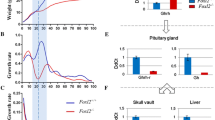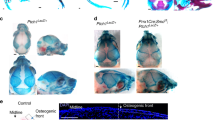Abstract
Mutations in the gene encoding the gap-junctional protein connexin43 (Cx43) are the cause of the human disease oculodentodigital dysplasia (ODDD). The mandible is often affected in this disease, with clinical reports describing both mandibular overgrowth and conversely, retrognathia. These seemingly opposing observations underscore our relative lack of understanding of how ODDD affects mandibular morphology. Using two mutant mouse models that mimic the ODDD phenotype (I130T/+ and G60S/+), we sought to uncover how altered Cx43 function may affect mandibular development. Specifically, mandibles of newborn mice were imaged using micro-CT, to enable statistical comparisons of shape. Tissue-level comparisons of key regions of the mandible were conducted using histomorphology, and we quantified the mRNA expression of several cartilage and bone cell differentiation markers. Both G60S/+ and I130T/+ mutant mice had altered mandibular morphology compared to their wildtype counterparts, and the morphological effects were similarly localized for both mutants. Specifically, the biggest phenotypic differences in mutant mice were focused in regions exposed to mechanical forces, such as alveolar bone, muscular attachment sites, and articular surfaces. Histological analyses revealed differences in ossification of the intramembranous bone of the mandibles of both mutant mice compared to their wildtype littermates. However, chondrocyte organization within the secondary cartilages of the mandible was unaffected in the mutant mice. Overall, our results suggest that the morphological differences seen in G60S/+ and I130T/+ mouse mandibles are due to delayed ossification and suggest that mechanical forces may exacerbate the effects of ODDD on the skeleton.






Similar content being viewed by others
Data Availability
Data are available from the authors upon request.
References
Duan X, Bradbury SR, Olsen BR, Berendsen AD (2016) VEGF stimulates intramembranous bone formation during craniofacial skeletal development. Matrix Biol 52–54:127–140. https://doi.org/10.1016/j.matbio.2016.02.005
Day TF, Guo X, Garrett-Beal L, Yang Y (2005) Wnt/β-catenin signaling in mesenchymal progenitors controls osteoblast and chondrocyte differentiation during vertebrate skeletogenesis. Dev Cell 8(5):739–750. https://doi.org/10.1016/J.DEVCEL.2005.03.016
Gupta A, Anderson H, Buo AM, Moorer MC, Ren M, Stains JP (2016) Communication of cAMP by connexin43 gap junctions regulates osteoblast signaling and gene expression. Cell Signal 28(8):1048–1057. https://doi.org/10.1016/j.cellsig.2016.04.014
Zappitelli T, Aubin JE (2014) The ‘connexin’ between bone cells and skeletal functions. J Cell Biochem 115(10):1646–1658. https://doi.org/10.1002/jcb.24836
Lecanda F, Warlow PM, Sheikh S, Furlan F, Steinberg TH, Civitelli R (2000) Connexin43 deficiency causes delayed ossification, craniofacial abnormalities, and osteoblast dysfunction. J Cell Biol 151(4):931–943. https://doi.org/10.1083/jcb.151.4.931
Donahue HJ et al (2009) Chondrocytes isolated from mature articular cartilage retain the capacity to form functional gap junctions. J Bone Miner Res 10(9):1359–1364. https://doi.org/10.1002/jbmr.5650100913
Civitelli R, Beyer EC, Warlow PM, Robertson AJ, Geist ST, Steinberg TH (1993) Connexin43 mediates direct intercellular communication in human osteoblastic cell networks. J Clin Invest 91(5):1888–1896. https://doi.org/10.1172/JCI116406
Chaible LM, Sanches DS, Cogliati B, Mennecier G, Lucia M, Dagli Z (2011) Delayed osteoblastic differentiation and bone development in Cx43 knockout mice. Toxicol Pathol 39(7):1046–1055. https://doi.org/10.1177/0192623311422075
Paznekas WA et al (2003) Connexin 43 (GJA1) mutations cause the pleiotropic phenotype of oculodentodigital dysplasia. Am J Hum Genet 72(2):408–418. https://doi.org/10.1086/346090
Paznekas WA et al (2009) GJA1 mutations, variants, and connexin 43 dysfunction as it relates to the oculodentodigital dysplasia phenotype. Hum Mutat 30(5):724–733. https://doi.org/10.1002/humu.20958
van Es RJJ, Wittebol-Post D, Beemer FA (2007) Oculodentodigital dysplasia with mandibular retrognathism and absence of syndactyly: a case report with a novel mutation in the connexin 43 gene. Int J Oral Maxillofac Surg 36(9):858–860. https://doi.org/10.1016/j.ijom.2007.03.004
Laird DW (2014) Syndromic and non-syndromic disease-linked Cx43 mutations. FEBS Lett 588(8):1339–1348. https://doi.org/10.1016/j.febslet.2013.12.022
Flenniken AM et al (2005) A Gja1 missense mutation in a mouse model of oculodentodigital dysplasia. Development 132(19):4375–4386. https://doi.org/10.1242/dev.02011
Kalcheva N et al (2007) Gap junction remodeling and cardiac arrhythmogenesis in a murine model of oculodentodigital dysplasia. Proc Natl Acad Sci USA 104(51):20512–20516. https://doi.org/10.1073/pnas.90.18.8424
Dobrowolski R et al (2008) The conditional connexin43G138R mouse mutant represents a new model of hereditary oculodentodigital dysplasia in humans. Hum Mol Genet 17(4):539–554. https://doi.org/10.1093/hmg/ddm329
Stewart MKG, Gong X-Q, Barr KJ, Bai D, Fishman GI, Laird DW (2013) The severity of mammary gland developmental defects is linked to the overall functional status of Cx43 as revealed by genetically modified mice. Biochem J 449(2):401–413. https://doi.org/10.1042/BJ20121070
McLachlan E et al (2008) ODDD-linked Cx43 mutants reduce endogenous Cx43 expression and function in osteoblasts and inhibit late stage differentiation. J Bone Miner Res 23(6):928–938. https://doi.org/10.1359/jbmr.080217
Jarvis SE et al (2020) Effects of reduced connexin43 function on skull development in the Cx43I130T/+ mutant mouse that models oculodentodigital dysplasia. Bone. https://doi.org/10.1016/j.bone.2020.115365
Watkins M, Grimston SK, Yi J, Guillotin B, Shaw A (2011) Osteoblast connexin43 modulates skeletal architecture by regulating both arms of bone remodeling. Mol Biol Cell. https://doi.org/10.1091/mbc.E10-07-0571
Atchley WR, Hall BK (1991) A model for development and evolution of complex morphological structures. Biol Rev 66(2):101–157. https://doi.org/10.1111/j.1469-185X.1991.tb01138.x
Shibata S et al (2004) Runx2-deficient mice lack mandibular condylar cartilage and have deformed Meckel’s cartilage. Anat Embryol (Berlin) 208(4):273–280. https://doi.org/10.1007/s00429-004-0393-2
Shibata S, Suda N, Suzuki S, Fukuoka H, Yamashita Y (2006) An in situ hybridization study of Runx2, Osterix, and Sox9 at the onset of condylar cartilage formation in fetal mouse mandible. J Anat 208(2):169–177. https://doi.org/10.1111/j.1469-7580.2006.00525.x
Willmore KE, Leamy L, Hallgrímsson B (2006) Effects of developmental and functional interactions on mouse cranial variability through late ontogeny. Evol Dev 8(6):550–567. https://doi.org/10.1111/j.1525-142X.2006.00127.x
Klingenberg CP (2010) Evolution and development of shape: integrating quantitative approaches. Nat Rev Genet 11(9):623–635. https://doi.org/10.1038/nrg2829
Cardini A, Elton S (2007) Sample size and sampling error in geometric morphometric studies of size and shape. Zoomorphology 126(2):121–134. https://doi.org/10.1007/s00435-007-0036-2
Ho T-V et al (2015) Integration of comprehensive 3D microCT and signaling analysis reveals differential regulatory mechanisms of craniofacial bone development. Dev Biol 400(2):180–190. https://doi.org/10.1016/J.YDBIO.2015.02.010
von Cramon-Taubadel N, Frazier BC, Lahr MM (2007) The problem of assessing landmark error in geometric morphometrics: Theory, methods, and modifications. Am J Phys Anthropol 134(1):24–35. https://doi.org/10.1002/ajpa.20616
Adams D, Collyer M, Kaliontzopoulou A (2018) Geometric morphometric analyses of 2D/3D landmark data. https://cran.r-project.org/web/packages/geomorph/geomorph.pdf. Accessed 22 Oct 2018
Gower JC (1975) Generalized procrustes analysis. Psychometrika 40(1):33–51. https://doi.org/10.1007/BF02291478
Green RM et al (2017) Developmental nonlinearity drives phenotypic robustness. Nat Commun. https://doi.org/10.1038/s41467-017-02037-7
Collyer ML, Sekora DJ, Adams DC (2015) A method for analysis of phenotypic change for phenotypes described by high-dimensional data. Heredity (Edinb) 115(4):357–365. https://doi.org/10.1038/hdy.2014.75
Lele S, Richtsmeier JT (1991) Euclidean distance matrix analysis: a coordinate-free approach for comparing biological shapes using landmark data. Am J Phys Anthropol 86:415–427
Lele SR, Richtsmeier JT (2001) An invariant approach to statistical analysis of shapes. Chapman & Hall, Philadelphia
Klingenberg CP (2016) Size, shape, and form: concepts of allometry in geometric morphometrics. Dev Genes Evol 226(3):113–137. https://doi.org/10.1007/s00427-016-0539-2
Schmitz N, Laverty S, Kraus VB, Aigner T (2010) Basic methods in histopathology of joint tissues. Osteoarthr Cartil 18:S113–S116. https://doi.org/10.1016/J.JOCA.2010.05.026
Zhao Q, Eberspaecher H, Lefebvre V, de Crombrugghe B (1997) Parallel expression of Sox9 andCol2a1 in cells undergoing chondrogenesis. Dev Dyn 209(4):377–386. https://doi.org/10.1002/(SICI)1097-0177(199708)209:4<377:AID-AJA5>3.0.CO;2-F
Akiyama H, Chaboissier M-C, Martin JF, Schedl A, de Crombrugghe B (2002) The transcription factor Sox9 has essential roles in successive steps of the chondrocyte differentiation pathway and is required for expression of Sox5 and Sox6. Genes Dev 16(21):2813–2828. https://doi.org/10.1101/gad.1017802
Shibata S, Fukada K, Suzuki S, Yamashita Y (1997) Immunohistochemistry of collagen types II and X, and enzyme-histochemistry of alkaline phosphatase in the developing condylar cartilage of the fetal mouse mandible. J Anat 191(4):561–570
Schmid TM, Linsenmayer TF (1985) Immunohistochemical localization of short chain cartilage collagen (type X) in avian tissues. J Cell Biol 100(2):598–605. https://doi.org/10.1083/JCB.100.2.598
Otto F et al (1997) Cbfa1, a candidate gene for cleidocranial dysplasia syndrome, is essential for osteoblast differentiation and bone development. Cell 89(5):765–771. https://doi.org/10.1016/S0092-8674(00)80259-7
Takeda S, Bonnamy JP, Owen MJ, Ducy P, Karsenty G (2001) Continuous expression of Cbfa1 in nonhypertrophic chondrocytes uncovers its ability to induce hypertrophic chondrocyte differentiation and partially rescues Cbfa1-deficient mice. Genes Dev 15(4):467–481. https://doi.org/10.1101/gad.845101
Nakashima K et al (2002) The novel zinc finger-containing transcription factor osterix is required for osteoblast differentiation and bone formation. Cell 108(1):17–29. https://doi.org/10.1016/S0092-8674(01)00622-5
Poole KES et al (2005) Sclerostin is a delayed secreted product of osteocytes that inhibits bone formation. FASEB J 19(13):1842–1844. https://doi.org/10.1096/fj.05-4221fje
Untergasser A et al (2012) Primer3—new capabilities and interfaces. Nucleic Acids Res 40(15):e115. https://doi.org/10.1093/nar/gks596
Koressaar T, Remm M (2007) Enhancements and modifications of primer design program Primer3. Bioinformatics 23(10):1289–1291. https://doi.org/10.1093/bioinformatics/btm091
Buo AM, Tomlinson RE, Eidelman ER, Chason M, Stains JP (2017) Connexin43 and Runx2 interact to affect cortical bone geometry, skeletal development, and osteoblast and osteoclast function. J Bone Miner Res 32(8):1727–1738. https://doi.org/10.1002/jbmr.3152
Willems E, Leyns L, Vandesompele J (2008) Standardization of real-time PCR gene expression data from independent biological replicates. Anal Biochem 379(1):127–129. https://doi.org/10.1016/j.ab.2008.04.036
Plotkin LI, Speacht TL, Donahue HJ (2015) Cx43 and mechanotransduction in bone. Curr Osteoporos Rep 13(2):67–72. https://doi.org/10.1007/s11914-015-0255-2
Batra N et al (2012) Mechanical stress-activated integrin α5β1 induces opening of connexin 43 hemichannels. Proc Natl Acad Sci USA 109(9):3359–3364. https://doi.org/10.1073/pnas.1115967109
Shen H, Grimston S, Civitelli R, Thomopoulos S (2015) Deletion of connexin43 in osteoblasts/osteocytes leads to impaired muscle formation. J Bone Miner Res 30(4):596–605. https://doi.org/10.1002/jbmr.2389
Shen H, Schwartz AG, Civitelli R, Thomopoulos S (2020) Connexin 43 is necessary for murine tendon enthesis formation and response to loading. J Bone Miner Res 35(8):1494–1503. https://doi.org/10.1002/jbmr.4018
Acknowledgements
We thank Mariyan Jeyarajah for sharing his qPCR expertise, Chris Norley for help with acquiring micro-computed tomography images, and Annie Lin and Ryan Masney for their assistance in sample preparation. This work was supported by a Natural Sciences and Engineering Research Council Discovery Grant (R5211A02) to KEW and a Canadian Institute of Health Research operating Grant (148630) to DWL.
Funding
None.
Author information
Authors and Affiliations
Contributions
AM: conceptualization, data collection, data analysis, writing—Original draft, review, and editing. JW, EJ, and KB: data collection, review, and editing. . DL: resources, review and editing, funding. KW: conceptualization, resources, writing—original draft, writing—editing and review, and validation.
Corresponding author
Ethics declarations
Conflict of interest
Alyssa Moore, Jessica Wu, Elizabeth Jewlal, Kevin Barr, Dale Laird, and Katherine Willmore declare that they have no conflict of interest.
Human and Animal Rights
All experiments were approved by the Animal Care Committee at the University of Western Ontario (2018-061) and abide by the guidelines of the Canadian Council on Animal Care.
Additional information
Publisher's Note
Springer Nature remains neutral with regard to jurisdictional claims in published maps and institutional affiliations.
Electronic supplementary material
Below is the link to the electronic supplementary material.
Rights and permissions
About this article
Cite this article
Moore, A.C., Wu, J., Jewlal, E. et al. Effects of Reduced Connexin43 Function on Mandibular Morphology and Osteogenesis in Mutant Mouse Models of Oculodentodigital Dysplasia. Calcif Tissue Int 107, 611–624 (2020). https://doi.org/10.1007/s00223-020-00753-9
Received:
Accepted:
Published:
Issue Date:
DOI: https://doi.org/10.1007/s00223-020-00753-9




